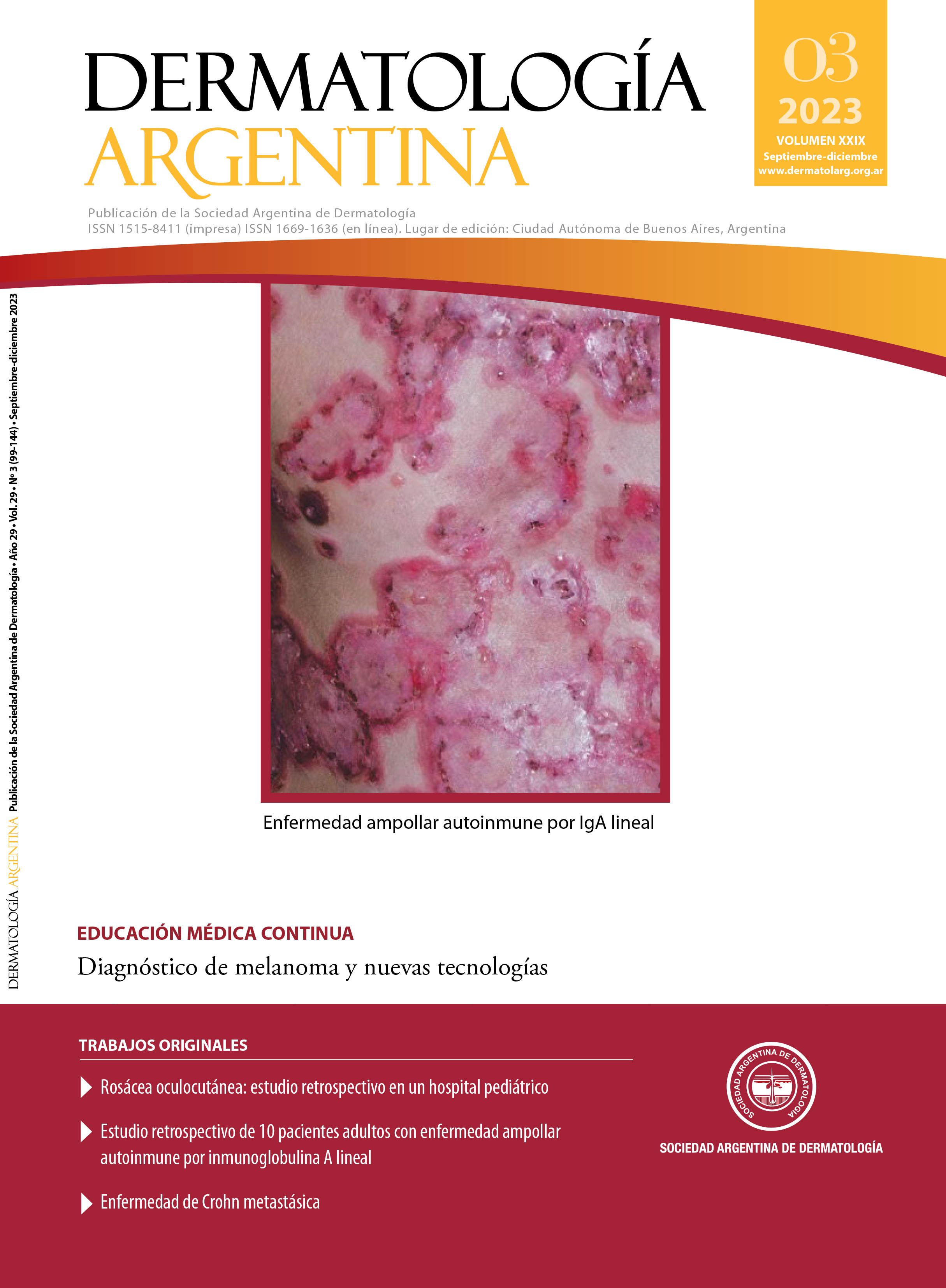Oculocutaneous rosacea: a retrospective study in a pediatric hospital
DOI:
https://doi.org/10.47196/da.v29i3.2441Keywords:
rosacea, ocular rosacea, childrenAbstract
Background: cutaneous rosacea (CR) is a chronic inflammatory skin condition, that occurs more frequently in adults. Prevalence in children is unknown. This entity presents erythema, flushing, telangiectasias, papules, pustules, glandular hypertrophy and/or fibrosis. There may be ocular affection, before, concomitant or after skin involvement. Ocular involvement may be the unique manifestation. Treatment is based on skin care, avoiding triggers, and topical and/or systemic treatment with anti-inflammatory activity.
Objectives: the aim of this study is to describe the cutaneous and ocular manifestations and treatment of the patients with a diagnosis of oculocutaneous rosacea (OCR).
Design: retrospective, descriptive and cross-sectional study.
Methods: medical records of patients with a diagnosis of ROC evaluated in our hospital from January 2011 to March 2017 were reviewed.
Results: we evaluated 25 patients with a diagnosis of OCR with an age between 1 to 19 years. Predominance of the papulo-pustular subtype was observed, two patients had the fimatous subtype and one of these presented as granulomatous variant, very rare in children. Ocular involvement was present in over 52% of the patients being, blepharitis the most frequent condition. Therapeutic approach Treatment options were according to the severity of the skin and ocular involvement.
Conclusions: ocular involvement in patients with a diagnosis of CR is frequent. We emphasized the importance of suspecting ocular rosacea in all patients with a diagnosis of CR associated with recurrent episodes of blepharitis and chalazion. The ophthalmological evaluation should be indicated in all patients with a diagnosis of CR regardless of the degree of skin involvement.
References
I. Kellen R, Silverberg NB. Pediatric rosacea. Cutis. 2016;98:49-53.
II. Bernal LE, Zarco AP, Campos P, Arenas R. Rosácea infantil. Bol Med Hosp Infant Mex. 2019;76:95-99.
III. Rodríguez-Acar M, Martínez-Muñoz JA. Rosácea infantil. Rev Cent Dermatol Pascua. 2011;20:18-21.
IV. Chamaillard M, Mortemousque B, Boralevi F, Marques da Costa C, et ál. Cutaneous and ocular signs of childhood rosacea. Arch Dermatol. 2008;144:167-171.
V. Drolet B, Paller AS. Childhood rosacea. Pediatr Dermatol. 1992;9:22-26.
VI. Ooi XT, Tan KB, Chandran N. A case of pediatric rosacea-skin and ocular involvement. Clin Case Rep. 2019;7:2414-2416.
VII. Spoendlin J, Voegel JJ, Jick SS, Meier CR. A study on the epidemiology of rosacea in the U.K. Br J Dermatol. 2012;167:598-605.
VIII. Miguel AIM, Salgado MB, Lisboa MS, Henriques F, et ál. Pediatric ocular rosacea: 2 cases. Eur J Ophthalmol. 2012;4:664-666.
IX. Troielli P, González-Otero FM, Ríos Yuil JM, Vázquez-Martínez OT, et ál. Actualización y recomendaciones para el diagnóstico y tratamiento de la rosácea. Med Cutan Ibero Lat Am. 2016;44:7-26.
X. Kaminsky A, Flórez-White M, Piquero-Martín J, Herane MI, et ál. Informe del consenso Ibero-Latinoamericano 2016 sobre la clasificación clínica y terapéutica de la rosácea. Med Cutan Iber Lat Am. 2016;44:6-10.
XI. Keshtcar-Jafari A, Akhyani M, Ehsani AH, Ghiasi M, et ál. Correlation of the severity cutaneous rosacea with ocular rosacea. Indian J Dermatol Venereol Leprol. 2009;75: 405-406.
XII. Potz-Biedermann C, Mehra T, Deuter C, Zierhut M, et ál. Ophthalmic rosacea: case report in a child and treatment recommendations. Pediatr Dermatol. 2015;32:522-525.
XIII. Di Matteo MC, Stefano PC, Cirio A, López B, et ál. Rosácea oculocutánea en un niño. Arch Argent Pediatr. 2019;117:170-172.
XIV. Mássimo I, Andrada R, Hernández H, Mássimo JA. Rosácea en la infancia. Rev Hosp Niños B Aires. 2008;50:188-192.
XV. Martínez MF, Piegari Feliú MA, Di Matteo MC, Tellería RL, et ál. Microbiota: un ecosistema inteligente. Dermatol Argent. 2022;28:143-149.
XVI. Soto AC, Villani ME, Sánchez G, Merola G. Rosácea granulomatosa en la infancia. Dermatol Argent. 2019;25:84-86.
XVII. Boralevi, F, Léauté-Labrèze C, Lepreux S, Barbarot S, et ál. Idiopathic facial aseptic granuloma: a multicentre prospective study of 30 cases. Br J Dermatol. 2007;156:705-708.
XVIII. Docampo-Simón A, Sánchez-Pujol MJ, Schneller-Pavelescu L, Berbegal L, et ál. Granuloma aséptico facial idiopático: características clinicopatológicas y ecográficas. An Pediatr (Barc). 2020;92:297-299.
XIX. Garais JA, Bonetto VN, Frontino L, Salduna MD, et ál. Granuloma aséptico facial idiopático. A propósito de un caso. Arch Argent Pediatr. 2019;117:56-58.
Downloads
Published
Issue
Section
License
Copyright (c) 2023 on behalf of the authors. Reproduction rights: Argentine Society of Dermatology

This work is licensed under a Creative Commons Attribution-NonCommercial-NoDerivatives 4.0 International License.
El/los autor/es tranfieren todos los derechos de autor del manuscrito arriba mencionado a Dermatología Argentina en el caso de que el trabajo sea publicado. El/los autor/es declaran que el artículo es original, que no infringe ningún derecho de propiedad intelectual u otros derechos de terceros, que no se encuentra bajo consideración de otra revista y que no ha sido previamente publicado.
Le solicitamos haga click aquí para imprimir, firmar y enviar por correo postal la transferencia de los derechos de autor











